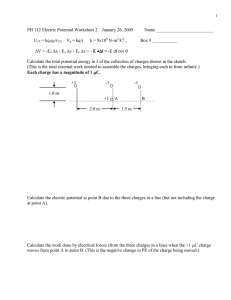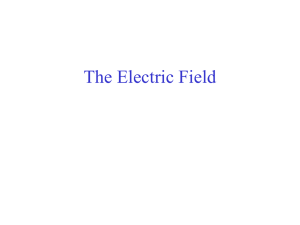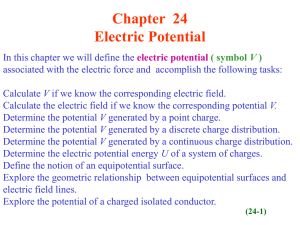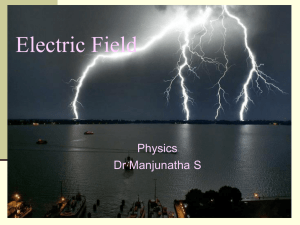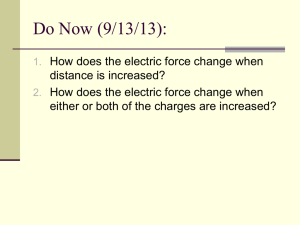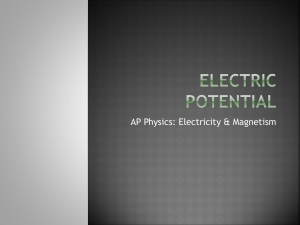Chapter 24 Electric Potential
advertisement
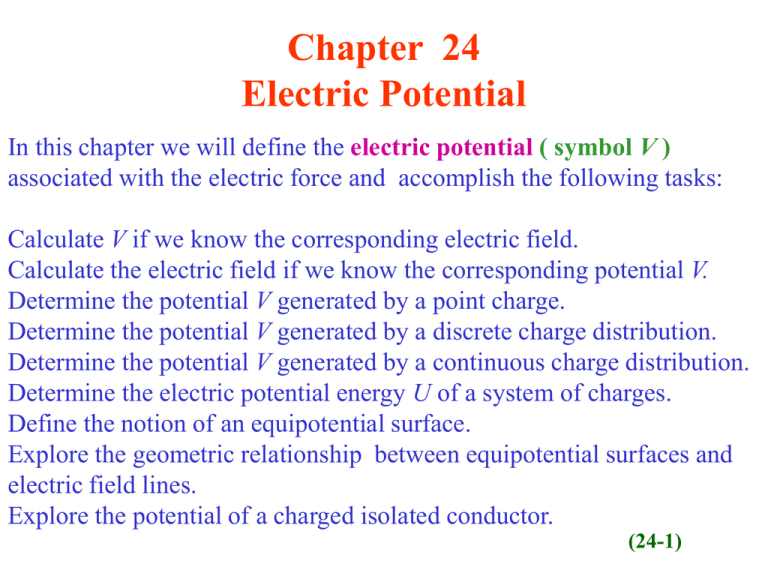
Chapter 24 Electric Potential In this chapter we will define the electric potential ( symbol V ) associated with the electric force and accomplish the following tasks: Calculate V if we know the corresponding electric field. Calculate the electric field if we know the corresponding potential V. Determine the potential V generated by a point charge. Determine the potential V generated by a discrete charge distribution. Determine the potential V generated by a continuous charge distribution. Determine the electric potential energy U of a system of charges. Define the notion of an equipotential surface. Explore the geometric relationship between equipotential surfaces and electric field lines. Explore the potential of a charged isolated conductor. (24-1) xf U F ( x)dx Electric Potential Energy In Chapter 8 we defined the change in potential xi F(x) .O . xi . energy U associated with a conservative force as the negative value of the work W that the force x xf x must do on a particle to take it from an initial position xi to a final position x f . xf U U f U i W F ( x)dx f U q0 E ds xi i Consider an electric charge q0 moving from an initial position at point A to a final position at point B under the influence of a A known electric field E. The force exerted on the charge is F q0 E. B f f i i U F ds q0 E ds (24-2) Checkpoint 1: In the figure, a proton moves from point i to point f in a uniform electric field directed as shown. a) Does the electric field do positive or negative work on the proton? b) Does the electric potential energy of the proton increase or decrease? c) Does the force do positive or negative work? d) Does the proton move to a point of higher or lower potential? P VP E ds The Electric Potential V The change in potential energy of a charge q0 A moving under the influence of E from point A f to point B is: U U f U i W q0 E ds . i B Please note that U depends on the value of q0 . We define the electric potential V in such a manner so that it is independent U W of q0 : V q0 q0 f Here V V f Vi V f Vi E ds . i In all physical problems only changes in V are involved. Thus we can define arbitrarily the value of V at a reference point, which we choose to be at infinity: V f V 0. We take the initial position as the generic point P with potential VP : P VP E ds . The potential VP depends only on the coordinates of P and on E. (24-3) Electric potential is a scalar property associated with an electric field, regardless of whether a charged object has been placed in that field; it is measured in joules per coulomb or volts. V Electric potential energy is an energy of a charged object in an external electric filed ( or more precisely, an energy of the system consisting of the object and the external electric field); it is measured in joules. U W qV Equipotential Surfaces A collection of points that have the same potential is known as an equipotential surface. Four such surfaces are shown in the figure. The work done by E as it moves a charge q between two points that have a potential difference V is given by W qV . For path I : WI 0 because V 0. For path II: WII 0 because V 0. For path III: WIII qV q V2 V1 . For path IV: WIV qV q V2 V1 . Note : When a charge is moved on an equipotential surface V 0 the work done by the electric field is zero: W 0. (24-10) The Electric Field E is Perpendicular to the Equipotential Surfaces Consider the equipotential surface at potential V . A charge q is moved E F A q V r B S by an electric field E from point A to point B along a path r . Points A and B and the path lie on S . Let's assume that the electric field E forms an angle with the path r . The work done by the electric field is: W F r F r cos qE r cos . We also know that W 0. Thus: qE r cos 0, where q 0, E 0, r 0. Thus: cos 0 90. The correct picture is shown in the figure below. E S V (24-11) Examples of Equipotential Surfaces and the Corresponding Electric Field Lines Uniform electric field Isolated point charge Electric dipole Equipotential surfaces for a point charge q : q q V . Assume that V is constant r constant. 4 0 r 4 0V Thus the equipotential surfaces are spheres with their center at the point charge q and radius r . 4 0V (24-12) Checkpoint 3: The figure here shows a family or parallel equi potential surfaces ( in cross section) and five paths along which we shall move an electron from one surface to another. a) What is the direction of the electric field associated with the surfaces? b) For each path, is the work we do positive, negative, or zero? c) Rank the paths according to the work we do, Greatest first. VP 1 q 4 0 R Definition of voltage : V SI Units of V : W q0 Units of V : J/C, known as the volt Potential Due to a Point Charge Consider a point charge q placed at the origin. We will use the definition given on the previous page to determine the potential VP at point P a distance R from O. R R R VP E ds Edr cos 0 Edr The electric field generated by q is: q E 4 0 r 2 O VP q dr 4 0 R r 2 dr 1 x2 x q 1 1 q VP 4 0 r R 4 0 R (24-4) Potential Due to a Group of Point Charges q1 r1 q2 r2 q3 P r3 Consider the group of three point charges shown in the figure. The potential V generated by this group at any point P is calculated using the principle of superposition. 1. We determine the potentials V1 ,V2 , and V3 generated by each charge at point P: V V1 V2 V3 V1 q1 1 q2 1 q3 , V2 , V3 4 0 r1 4 0 r2 4 0 r3 1 2. We add the three terms: V V1 V2 V3 V q1 1 q2 1 q3 4 0 r1 4 0 r2 4 0 r3 1 The previous equation can be generalized for n charges as follows: 1 q1 1 q2 1 qn 1 V ... 4 0 r1 4 0 r2 4 0 rn 4 0 n qi 1 r i (24-5) Checkpoint 4: The figure here shows three arrangements of two protons, Rank the arrangements according to the net electric potential produced at point P by the protons, Greatest First Calculating the Electric Field E from the Potential V Now we will tackle the reverse problem, i.e., determine E if we know V . Consider two equipotential surfaces that correspond to the values V and V dV separated by a distance ds as shown in the figure. Consider an arbitrary direction represented by the vector ds . We will allow the electric field to move a charge q0 from the equipotential surface V to the surface V dV . A B V V+dV The work done by the electric field is given by: W q0 dV (eq. 1). Also W Fds cos Eq0 ds cos (eq. 2) If we compare these two equations we have: dV Eq0 ds cos q0 dV E cos . ds From triangle PAB we see that E cos is the component Es of E along the direction s. Thus: Es V . s Es V s (24-13) Es V s We have proved that Es V . s The component of E in any direction is the negative of the rate at which the electric potential changes with distance in this direction. A B V V+dV If we take s to be the x- , y -, and z -axes we get: V Ex x V Ey y V Ez z If we know the function V ( x, y, z ) we can determine the components of E and thus the vector E itself : E V ˆ V ˆ V ˆ i j k x y z (24-14) Potential Energy U of a System of Point Charges We define U as the work required to assemble the q2 y r12 system of charges one by one, bringing each charge from infinity to its final position. r23 Using the above definition we will prove that for a system of three point charges U is given by: q1 r13 q3 x O q2 q3 q1q3 q1q2 U 4 0 r12 4 0 r23 4 0 r13 Note : Each pair of charges is counted only once. For a system of n point charges U 1 4 0 n i , j 1 i j qi q j rij . qi the potential energy U is given by: Here rij is the separation between qi and q j . The summation condition i j is imposed so that, as in the case of three point charges, each pair of charges is counted only once. (24-15) y Step 1 q1 W1 0 x O Step 2 y q1 Step 1 : Bring in q1: r12 q2 (no other charges around) Step 2 : Bring in q2 : W2 q2V (2) V (2) q1 4 0 r12 W2 q1q2 4 0 r12 Step 3 : Bring in q3: W3 q3V (3) x O Step 3 r12 y q2 q1 r23 r13 q3 O x 1 q1 q2 V (3) 4 0 r13 r23 1 q1q3 q2 q3 W3 4 0 r13 r23 W W1 W2 W3 W qq qq q1q2 2 3 1 3 4 0 r12 4 0 r23 4 0 r13 (24-16) conductor path B E 0 A Potential of an Isolated Conductor We shall prove that all the points on a conductor (either on the surface or inside) have the same potential. A conductor is an equipotential surface. Consider two points A and B on or inside a conductor. The potential difference VB VA between these two points is given by the equation: B VB VA E d S . A We already know that the electrostatic field E inside a conductor is zero. Thus the integral above vanishes, and VB VA for any two points on or inside the conductor. (24-17) Isolated Conductor in an External Electric Field We already know that the surface of a conductor is an equipotential surface. We also know that the electric field lines are perpendicular to the equipotential surfaces. From these two statements it follows that the electric field vector E is perpendicular to the conductor surface, as shown in the figure. All the charges of the conductor reside on the surface and arrange themselves in such a way so that the net electric field inside the conductor Ein 0. The electric field just outside the conductor is: Eout . 0 (24-18) E n̂ Eout E Ein 0 nˆ 0 Electric Field and Potential in and around a Charged Conductor : A Summary n̂ 1. All the charges reside on the conductor surface. 2. The electric field inside the conductor is zero: Ein 0. 3. The electric field just outside the conductor is: Eout . 0 4. The electric field just outside the conductor is perpendicular to the conductor surface. 5. All the points on the surface and inside the conductor have the same potential. The conductor is an equipotential surface. (24-19) Electric Field and Electric Potential for a Spherical Conductor of Radius R and Charge q R 1 q . 4 0 R For r R , V For r R , 1 q V . 4 0 r For r R , E For r R , E 1 q . 2 4 0 R 1 q . 2 4 0 r Note : Outside the spherical conductor, the electric field and the electric potential are identical to that of a point charge equal to the net conductor charge and placed at the center of the sphere. (24-20) Example 1: Example 2: Example 3: Example 4: Example 5: Example 6: Example 7: Example 8: Example 9: Example 10: Example 11: Example 12: Example 13: Example 14: Example 15: Example 16: Example 17: Example 18: Example 19: Example 20: Example 21: Example 22: Example 23: Example 24: Example 25: Example 26: Example 27: Example 28:
